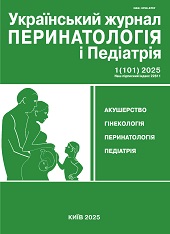Course features of IgA-associated vasculitis in children at the present stage
DOI:
https://doi.org/10.15574/PP.2025.1(101).96102Keywords:
children, IgA-associated vasculitis, the course features, medical recordsAbstract
IgA-associated vasculitis belongs to primary systemic vasculitides, and its frequency makes 3-27 cases per 100,000 children.
Aim - to establish the course features of IgA-associated vasculitis in children.
Materials and methods. 50 medical records of hospitalized patients who were treated at the Communal Non-Profit Enterprise "Ivano-Frankivsk Regional Children's Clinical Hospital of the Ivano-Frankivsk Regional Council" for IgA-associated vasculitis between 2015 and 2019 were analyzed. And 57 patients, aged 3 to 18 years, who were undergoing inpatient treatment between 2019 and 2024 were examined. The Group I includes 71 (66.4%) patients with IgA-vasculitis, associated with acute respiratory diseases. The Group II includes 36 (33.6%) patients with manifestation of illness after allergic reactions.
Results. Course features of vasculitis in patients of the Group I are as follows: age from 4 to 7 years (40.0% and 10.0%), duration of the disease before admission to the hospital - 14.0±2.5; male gender (71.0% and 29.0%). In patients of the Group I, the most common clinical form is articular (45.0%), while in the patients of the Group II, cutaneous (61.0%) form prevails accordingly. Kidney damage occurs in 10.0% patients of the Group I.
Conclusions. The prevalence of IgA-associated vasculitis in the Ivano-Frankivsk region coincides with similar data for Ukraine (8.0-12.0 cases per 100,000 children). The most meaningful signs in patients of the Group I includes: age, the duration of the illness before admission to the hospital, and gender features. The most common clinical form in the Group I patients is articular (45.0%), while in patients of the Group II - cutaneous (61.0%).
The research was carried out in accordance with the principles of the Helsinki Declaration. The study protocol was approved by the Local Ethics Committee of participating institution. The informed consent of the patient was obtained for conducting the studies.
No conflict of interests was declared by the authors.
References
Abu-Zaid MH, Salah S, Lotfy HM et al. (2021). Consensus evidence-based recommendations for treat-to-target management of immunoglobulin A vasculitis. Ther Adv Musculoskelet Dis. 13: 1759720. https://doi.org/10.1177/1759720X211059610; PMid:34917176 PMCid:PMC8669874
Allez M, Denis B, Bouaziz JD et al. (2020). COVID-19-related IgA vasculitis. Arthritis Rheumatol. 72: 1952-1953. https://doi.org/10.1002/art.41428; PMid:32633104 PMCid:PMC7361577
Batu ED, Sener S, Ozen S. (2022). COVID-19 associated pediatric vasculitis: a systematic review and detailed analysis of the pathogenesis. Semin Arthritis Rheum. 55: 152047. https://doi.org/10.1016/j.semarthrit.2022.152047; PMid:35709649 PMCid:PMC9183245
Becker RC. (2020). COVID-19-associated vasculitis and vasculopathy. J Thromb Thrombolysis. 50(3): 499-511. https://doi.org/10.1007/s11239-020-02230-4; PMid:32700024 PMCid:PMC7373848
Hastings MC, Rizk DV, Kiryluk K et al. (2022). IgA vasculitis with nephritis: update of pathogenesis with clinical implications. Pediatr Nephrol. 37: 719-733. https://doi.org/10.1007/s00467-021-04950-y; PMid:33818625 PMCid:PMC8490493
Jelusic M, Sestan M, Giani T, Cimaz R. (2022, Mar 15). New Insights and Challenges Associated With IgA Vasculitis and IgA Vasculitis With Nephritis-Is It Time to Change the Paradigm of the Most Common Systemic Vasculitis in Childhood? Front Pediatr. 10: 853724. https://doi.org/10.3389/fped.2022.853724; PMid:35372148 PMCid:PMC8965283
Leung AKC, Barankin B, Leong KF. (2020, May 7). Henoch-Schönlein Purpura in Children: An Updated Review. Curr Pediatr Rev. 16(4): 265-276. https://doi.org/10.2174/1573396316666200508104708; PMid:32384035
Neumann T. (2022). Update on immunoglobulin A vasculitis. Z Rheumatol. 81: 305-312. https://doi.org/10.1007/s00393-022-01162-z; PMid:35303751 PMCid:PMC8932091
Ozen S, Marks SD, Brogan P, Groot N, de Graeff N, Avcin T et al. (2019, Sep 1). European consensus-based recommendations for diagnosis and treatment of immunoglobulin A vasculitis-the SHARE initiative. Rheumatology (Oxford). 58(9): 1607-1616. https://doi.org/10.1093/rheumatology/kez041; PMid:30879080
Pillebout E, Sunderkötter C. (2021, Oct). IgA vasculitis. Semin Immunopathol. 43(5): 729-738. https://doi.org/10.1007/s00281-021-00874-9; PMid:34170395
Roache-Robinson P, Killeen RB, Hotwagner DT. (2023, Sep 26). IgA Vasculitis (Henoch-Schönlein Purpura). In: StatPearls [Internet]. Treasure Island (FL): StatPearls Publishing; 2024 Jan. PMID: 30725937.
Salem Y, Alam Z, Shalabi MM, Hosler GA, Acharya S. (2023, May 8). IgA Vasculitis Associated With COVID-19. Cureus. 15(5): e38725. PMID: 37292558; PMCID: PMC10246862. https://doi.org/10.7759/cureus.38725
Vien S, Shieh C, Ko J, Tagore K. (2024). Diagnosis of Adult IgA Vasculitis With Gastrointestinal Involvement. Annals of Internal Medicine: Clinical Cases. 3; 9. https://doi.org/10.7326/aimcc.2024.0036
Watts RA, Hatemi G, Burns JC, Mohammad AJ. (2022, Jan). Global epidemiology of vasculitis. Nat Rev Rheumatol. 18(1): 22-34. Epub 2021 Dec 1. https://doi.org/10.1038/s41584-021-00718-8; PMid:34853411 PMCid:PMC8633913
Downloads
Published
Issue
Section
License
Copyright (c) 2025 Ukrainian Journal of Perinatology and Pediatrics

This work is licensed under a Creative Commons Attribution-NonCommercial 4.0 International License.
The policy of the Journal “Ukrainian Journal of Perinatology and Pediatrics” is compatible with the vast majority of funders' of open access and self-archiving policies. The journal provides immediate open access route being convinced that everyone – not only scientists - can benefit from research results, and publishes articles exclusively under open access distribution, with a Creative Commons Attribution-Noncommercial 4.0 international license(СС BY-NC).
Authors transfer the copyright to the Journal “MODERN PEDIATRICS. UKRAINE” when the manuscript is accepted for publication. Authors declare that this manuscript has not been published nor is under simultaneous consideration for publication elsewhere. After publication, the articles become freely available on-line to the public.
Readers have the right to use, distribute, and reproduce articles in any medium, provided the articles and the journal are properly cited.
The use of published materials for commercial purposes is strongly prohibited.

